
|
Vente N° 75
| Lot |
Photo |
Description |
Prix atteint |
Lot 1635 |
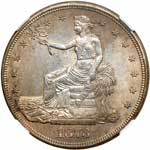 |
1873-CC. NGC graded AU-58. Well struck and toned. A gleaming, still highly lustrous example of the higher quality for this popularly collected Trade Dollar design. Much original luster blends smoothly with pale golden highlights on the frosted surfaces. Here, too, we are struck by the nice, convincing design detail for all areas on the eagle of this important Carson City Mint rarity with not even the slightest amount of flatness on the leg or neck feathers. On the obverse, all stars and most of Liberty�s head detail complete. Pop 35; 35 finer, 6 in 60, 8 in 61, 8 in 62, 7 in 63, 5 in 64, 1 in 65.
Historic account: In an attempt to obtain the best possible design for the new Trade Dollar, Mint Director Linderman used a provision of the new Coinage Act of 1873 to hire outside artists. There were several patterns made for the 1873 trade dollar, but in the end Linderman chose one by Chief Engraver William Barber. The adopted design had the familiar figure of a seated Liberty, but in a somewhat different pose from the regular coinage.There was a great deal of ceremony connected with the first trade dollar coinage, and mintage was heavy for quite some time. Most of the 1873 coinage did go to the Orient, as intended in the legislation, but by 1874 the ever-declining world price of silver made it advantageous to dump many of the trade dollars on the American domestic market for whatever they would bring.By 1876 the dumping of trade dollars had become so prevalent that the government withdrew the legal-tender status of the coin. The market value then fell to about 80 cents, varying with the price of silver on the open market.The fall of silver made the owners of bullion even more desperate to get rid of their excess metal, and large numbers of trade dollars were made in 1876 and 1877 despite growing antagonism toward them by the public. There were always, however, unscrupulous individuals willing to put them in circulation at the expense of someone else. Estimated Value $5,000 - 5,500
Voir détails et photos agrandies
| Invendu |
Lot 1636 |
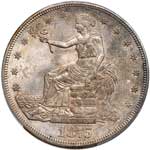 |
1875-CC. PCGS graded MS-64. Nicely toned. Intensely blazing luster explodes like a fire storm on the satiny, chiefly toned surfaces of this carefully preserved and accurately graded MS64 Trade Dollar. A range of dancing toned highlight reveal underneath decent (but not bold) hair on the Liberty's head, with full stars around and decidedly superior strike at the centers than usually found. A scarce Mint State representative of the Carson City Mint production this year. Pop 27; 2 finer, 1 in 64+, 1 in 66. (PCGS # 7038) Estimated Value $6,000 - 6,500
Voir détails et photos agrandies
Voir résultats de pareils lots
| Invendu |
Lot 1637 |
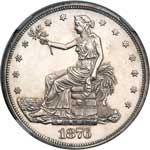 |
1876. NGC graded Proof 61. Fully untoned proof. Estimated Value $1,500 - 1,600
Voir détails et photos agrandies
| Prix atteint
$1,783 |
Lot 1638 |
 |
1876. NGC graded MS-62. Nice light toning on both sides. Estimated Value $800 - 850
Voir détails et photos agrandies
| Prix atteint
$1,208 |
Lot 1639 |
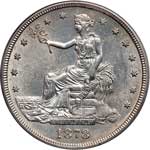 |
1878-S. PCGS graded MS-62. Well struck and untoned. A lustrous late-issue Trade Dollar with characteristic finely detailed devices of a San Francisco Mint product. In 1879-83, no further business strikes were made, only Proofs as the time slowly came to abolish this denomination (which occurred officially in 1887) (PCGS # 7048) Estimated Value $800 - 850
Voir détails et photos agrandies
Voir résultats de pareils lots
| Prix atteint
$1,208 |
Lot 1640 |
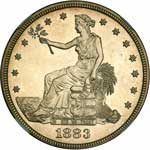 |
1883. NGC graded Proof 65. A touch of delicate golden toning graces the borders. Only 979 proofs minted for this Proof-only year. Pop 52; 45 finer
An impressive looking and well featured Gem Proof. This abbreviated series spanned the years 1873 to 1883 and Proofs were sold to collectors each year, either in Proof sets or individually. Today, Gems are very scarce.
Regular issue Silver Dollars had always been shunned by Easterners, who had refused to lug bulky coins around with them in their pockets and purses. Paper money was the preferred medium of exchange for all larger purchases. And yet, the Mint kept right on striking Silver Dollars. That is, they were made each year until 1873, when Congress passed the Act of 1873 demonetizing Silver Dollars (at the time, Seated Dollars). Instead, a new Trade Dollar was introduced. The Trade Dollar was meant to circulate in the Far East, specifically in the China trade, which then was burgeoning.
However, quick-witted Americans soon began to buy them up at their bullion value which was less than face value. (Since Trade Dollars had never been monetized they could not technically be placed into circulation in the States.) The hoarders then sold to jobbers who turned around and wholesaled them to employers. The employers foisted them off on their captive employees, making a small, but useful profit in the process! Imagine the stink that would arise if your employer were to pay your wages in, say, Canadian dollars, and you get some idea of the hassle US Trade Dollars caused. Congress finally solved the mess in 1887 when it canceled the issue's authorization and ceased production. Estimated Value $5,000 - 5,500
Voir détails et photos agrandies
| Prix atteint
$6,325 |
|
|